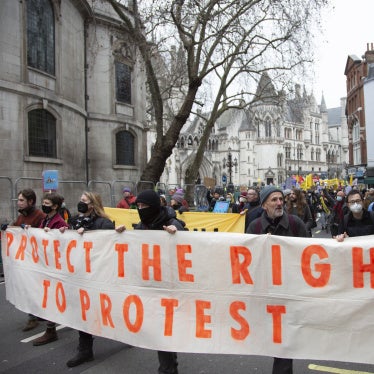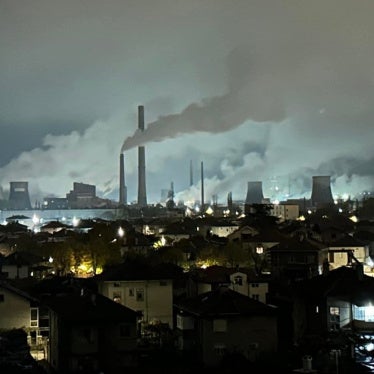(Kiev) – Riot police brutally beat several people, including a 17-year-old, who were detained on January 20, 2014, during a standoff in Kiev. In the early hours the next day, unidentified assailants kidnapped two activists from a hospital and severely beat them; the body of one of them was found the next day.
“Police in Kiev face serious challenges, but nothing can justify the vicious beatings we’ve documented,” said Yulia Gorbunova, Ukraine researcher at Human Rights Watch. “These are very serious crimes that need thorough investigation, and the people responsible should be held accountable. “
Beatings by Riot Police
On January 20, riot police detained and beat Mikhailo Niskoguz and at least two other people in front of central Kiev’s Dinamo Stadium, where antigovernment activists have been clashing violently with police intermittently since January 19. The clashes were the first in what has otherwise been two months of overwhelmingly nonviolent protests at Independence Square, known as “Maidan.”
Niskoguz, 17, told Human Rights Watch that a riot policeman hit him on the head and grabbed him as he was making room in his cell phone to take more pictures of the clashes. Four policemen dragged him several meters away from where they detained him, he said, and then made him run through a gantlet of police. The police beat him with their nightsticks and punched and kicked him while they shouted, among other things, “Tell everyone at Maidan if they don’t go home, tomorrow they’ll face death.” Niskoguz also heard some of the police shouting that they should not hit him in the face because there were many journalists around.
Niskoguz said that riot police stripped him naked on the spot in the subzero temperatures. Then one policeman cut the right side of Niskoguz’s buttock and thigh with a knife, saying, “This is for my colleague, who’s in a coma.” The cut left a 15-centimeter scar, Niskoguz said. The police also sprayed Niskoguz with pepper spray when he was naked and forced him to sing the Ukrainian national anthem, he said.
He said that after the police beat him for 10 minutes, they took him to a police van, where he lay for four hours before officers eventually called an ambulance. Niskoguz was taken to the prison ward of a hospital, where he received stitches for head injuries and was diagnosed with a concussion, three broken fingers, a broken elbow, and a broken toe. He has multiple, visible cuts on his face and left hand, and bruises all over his body.
“Riot police tortured Niskoguz,” Gorbunova said. “There is no other way to describe it.”
On January 22, Niskoguz was discharged from the hospital and taken directly to a court, which placed him under house arrest to await trial on mass rioting charges. His lawyer has filed a complaint with the prosecutor’s office about the assault.
Niskoguz said he saw police drag another man through the gantlet, where he was beaten unconscious. He did not know what became of the man. Niskoguz also said that at the same time police detained him, they detained, stripped, and beat a journalist, whom they released only after he showed his accreditation.
While in the hospital, Niskoguz shared a ward with seven other people, all of whom told him they had been beaten by police. Most, he said, had head injuries.
A doctor at a Kiev hospital told Human Rights Watch that since January 19, 32 people have been treated there for head wounds, concussions, broken bones, open wounds, and other injuries from police beatings. All were men between the ages of 20 and 50, and most were discharged.
Kidnapping, Beating, and Death of Yuri Verbitsky
In a separate incident, on January 21, at about 4 a.m., a Maidan activist, Igor Lutsenko, 35, accompanied another activist, Yuri Verbitsky, to Oktyabrsky Hospital to seek treatment for an eye injury. Several minutes after Lutsenko and Verbitsky arrived at the hospital, a group of 7 to 10 men dressed in civilian clothing stormed into the hospital, struck both men, twisted their arms behind their backs, and dragged them to a minivan, Lutsenko told Human Rights Watch.
Lutsenko said his captors kept him on the floor of the minivan while they drove for 20 to 30 minutes. When they arrived at a forest, the assailants removed both men from the car, forced them to their knees, and beat them, while asking general questions about who they were and what they do.
After about an hour, the captors drove Lutsenko and Verbitsky to a shed, took Lutsenko inside, put a bag over his head, twisted his arms behind his back, and made him lie on the floor.
Lutsenko told Human Rights Watch that while he was on the floor of the shed he could hear Verbitsky being beaten, screaming, and moaning nearby outside.
At one point several men entered the shed and beat Lutsenko for about 30 minutes, while asking questions such as how decisions are made at Maidan, who financed the movement, what Maidan activists were planning for the coming days, who controls the Right Sector – a nationalist movement – and who the “radicals” are at Maidan. About five or six hours later, by Lutsenko’s estimate, the men returned and questioned and beat him again.
Lutsenko said that between the first and second rounds of questioning, his captors carried in a man and put him on the floor next to Lutsenko. He could see only through the slits in the bag on his head, but judging from the fragments of clothing he could see, he believed the man was Verbitsky. They did not speak, Lutsenko said, but he could hear the other man breathing. About 30 minutes later, the captors took the man away.
Between one and two hours later, Lutsenko said, his captors drove him to another wooded area, freed his hands, and left him. Lutsenko was eventually able to free himself and seek help.
Lutsenko is in a hospital being treated for a concussion, broken teeth, multiple hematomas, open wounds in the soft tissue of his right leg, and other injuries.
On January 22, Verbitsky’s body was found in a village in the Kiev District. A preliminary hospital report said he died of hypothermia. No other information was available about any injuries he sustained.
Several factors pointed to the possibility that the abductors were in collusion with law enforcement and security services, Human Rights Watch said. The captors at one point told Lutsenko that once his ordeal was finished, he would be taken to a police station. Lutsenko also said his kidnappers seemed well organized, operated in a hierarchy, and focused their questioning on the antigovernment movement.
The Ukrainian authorities have opened a criminal investigation into the kidnapping and Verbitsky’s death. The investigation should be independent and effective and should include any evidence that points to government collusion, Human Rights Watch said. Those responsible should be brought to justice.
“The abduction of both men, leaving one seriously injured and the other dead, needs a comprehensive and transparent investigation,” Gorbunova said. “One way to ensure that this won’t happen again is for the authorities to make clear that those responsible will be brought to justice.”






